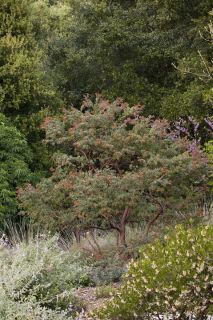» Home
» About
» Membership
» Journal
» Sparoza Garden
» Branches
» MGS Forum
» Seed Exchange
» Donations
» MGS Excursions
» Information
» Members' Gardens
» Book Reviews
» News & Views
» Contact
» Search
|
A garden in California
Katherine Greenberg, MGS President 2000-2004
Before agriculture came to our valley, there were oak woodlands growing on the north-facing slopes, as evidenced by the natural vegetation on the hillside above our property. Many of the oaks were removed in the twentieth century and replaced with orchards and homes. By the time we acquired our property in the 1970s, it was covered with non-native annual grasses with oaks, bays, buckeyes, walnuts, and willows growing along the creek at the base of the slope.
We built our home in 1980 and designed the garden to integrate with the house and the natural features of the site. After clearing the annual grasses, I started planting a selection of drought-tolerant native plants, mindful of the need to conserve water in our summer-dry climate and inspired by the beauty of the oak woodlands, grasslands, and chaparral of the surrounding valley and the redwood forests of the East Bay Hills. The plants in the garden are natural companions in the wild and suited to the climate and conditions of the site. Once established, they require little or no supplementary irrigation.
The front garden showcases grasses, sages and manzanitas for a chaparral effect, and many of these plants attract hummingbirds and other pollinators. On the upper slope, Pacific wax myrtles, toyons, and coast live oaks blend with the natural oak woodland above the garden. A pergola shades the entrance to the house, and a gate by the front door opens on to a patio that we use for outdoor living. A small meadow of grasses and perennial wildflowers adds interest to this area.
The spreading canopy of an evergreen oak shades the pool terrace at the west end of the property. From here a path bordered by sedges and evergreen currant leads to a small grove of vine maples and a gravel terrace on the north side of the house. The lower slope features drifts of grasses weaving through silver-leaved sages and manzanitas. Bays and willows grow further down the slope along the creek, which attracts deer and other wildlife to the garden. All of the plants in the garden are deer-resistant, and they provide food and shelter for birds and small animals.
Paths meander through the garden, connecting a series of outdoor rooms and terraces, and the colors and textures of flowers, foliage, fruits, and bark add interest in every season of the year. After thirty years the oaks planted from small containers, or grown from acorns planted by squirrels and jays, have grown into mature trees. Our hillside garden is once again becoming an oak woodland, with sun-loving grasses, perennials, and chaparral shrubs growing in the open areas. It is a tranquil place for plants, people and wildlife.
California plant communities represented in the garden:
Chaparral: Arctostaphylos species (manzanitas), Ceanothus species (wild lilac), Cercis occidentalis (redbud), Epilobium canum (California fuchsia or hummingbird fuchsia), Garrya elliptica (coast silk-tassel), Heteromeles arbutifolia (toyon), Rhamnus californica (coffeeberry).
Grassland: Achillea millefolium (yarrow), Artemisia californica (California sagebrush), Eriogonum species (buckwheats), Eschscholzia californica (California poppy), Festuca californica (California fescue), Iris douglasiana (Douglas iris), Muhlenbergia rigens (deer grass or basket grass).
Oak Woodland: Aesculus californica (buckeye), Heuchera species (coral bells), Mimulus aurantiacus (sticky monkeyflower), Penstemon heterophyllus (foothill penstemon), Quercus agrifolia (coast live oak), Quercus lobata (valley oak), Ribes viburnifolium (evergreen currant or Catalina perfume), Salvia spathacea (hummingbird sage).
Redwood Forest: Acer circinatum (vine maple), Asarum caudatum (wild ginger), Berberis aquifolium (Oregon grape), Myrica californica (Pacific wax myrtle), Polystichum munitum (western sword fern), Sequoia sempervirens (coast redwood).
Riparian Woodland: Dryopteris arguta (wood fern), Holodiscus discolor (cream bush or ocean spray), Juglans hindsii (California black walnut), Symphoricarpos albus (snowberry), Umbellularia californica (California bay), Vitis californica (California grape).

Entry garden with salvias and grasses.

Salvia spathacea (hummingbird sage)
and Muhlenbergia rigens (deer grass).

Patio garden and pool area with Quercus agrifolia (coast live oak) in background.

Gravel path bordered with irises and
western bleeding heart (Dicentra formosa).

Iris douglasiana 'Canyon Snow".

Arctostaphylos pajaroensis 'Paradise'
(Pajaro manzanita) with the new leaves
emerging and handsome red bark.

Weathered bench shaded by a California bay
tree overlooking Happy Valley Creek,

Katherine Greenberg, past President of the
Mediterranean Garden Society, in her garden.
|


